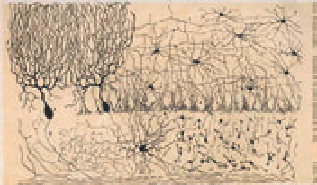Information Technology Reference
In-Depth Information
travels down the axon and is passed on to the dendrites of neighboring neurons
through the synapses (see
Fig. 13.15
). A typical neuron operates on a “thresh-
old” or “all-or-none” principle meaning that the input stimulation, represented
by the sum of all the incoming signals, must be above a certain threshold for
the cell to produce an output signal.
The cerebral cortex consists of up to six horizontal layers of neurons and
is about 2.5 millimeters or one-tenth of an inch thick. The neurons in each of
these layers connect vertically to neurons in adjacent layers. With these new
discoveries about the brain in the first half of the twentieth century, Nobel
Prize recipient Charles Sherrington poetically imagined how the workings of
the brain would look as it woke up from sleep:
(a)
(b)
The great topmost sheet of the mass, that where hardly a light had twinkled
or moved, becomes now a sparkling field of rhythmic flashing points with
trains of traveling sparks hurrying hither and thither. The brain is waking
and with it the mind is returning. It is as if the Milky Way entered upon
some cosmic dance. Swiftly the head mass becomes an enchanted loom
where millions of flashing shuttles weave a dissolving pattern, always a
meaningful pattern though never an abiding one; a shifting harmony of
subpatterns.
20
Fig. 13.14. Santiago Ramón y Cajal's
drawing of: (a) a Golgi-stained cortex of
a six-week-old human infant and (b) cells
of the chick cerebellum.
As we have seen, Wiener, von Neumann, Turing, and other early computer pio-
neers were fascinated with the possibility of computers performing operations
that would normally be classified as requiring intelligence. Warren McCulloch
and Walter Pitts had produced a simple mathematical model of a neuron that
only “fired” when the combination of its input signal exceeded a certain thresh-
old value (see
Fig. 13.16
). In their famous 1943 paper “A Logical Calculus of
the Ideas Immanent in Nervous Activity,” they showed that a network of such
neurons could carry out logical functions. They also suggested that, much like
a human brain, these artificial neural networks (ANNs) could learn by forming
new connections and by modifying the neural thresholds. Alan Turing put for-
ward similar ideas in an unpublished paper on “Intelligent Machinery” in 1948.
Turing suggested, “The cortex of an infant is an unorganised machine, which
can be organised by suitable interfering training.”
21
The basis of modern ANNs is a mathematical model of the neuron called
the
perceptron
introduced by Frank Rosenblatt in 1957. In the original model
Fig. 13.15. Sketch of a biological neural
network showing dendrites, axons, and
synapses.
Dendrite
Axon Te rminal
Node of
Ranvier
Cell body
Schwann cell
Axon
Myelin sheath
Nucleus



Search WWH ::

Custom Search